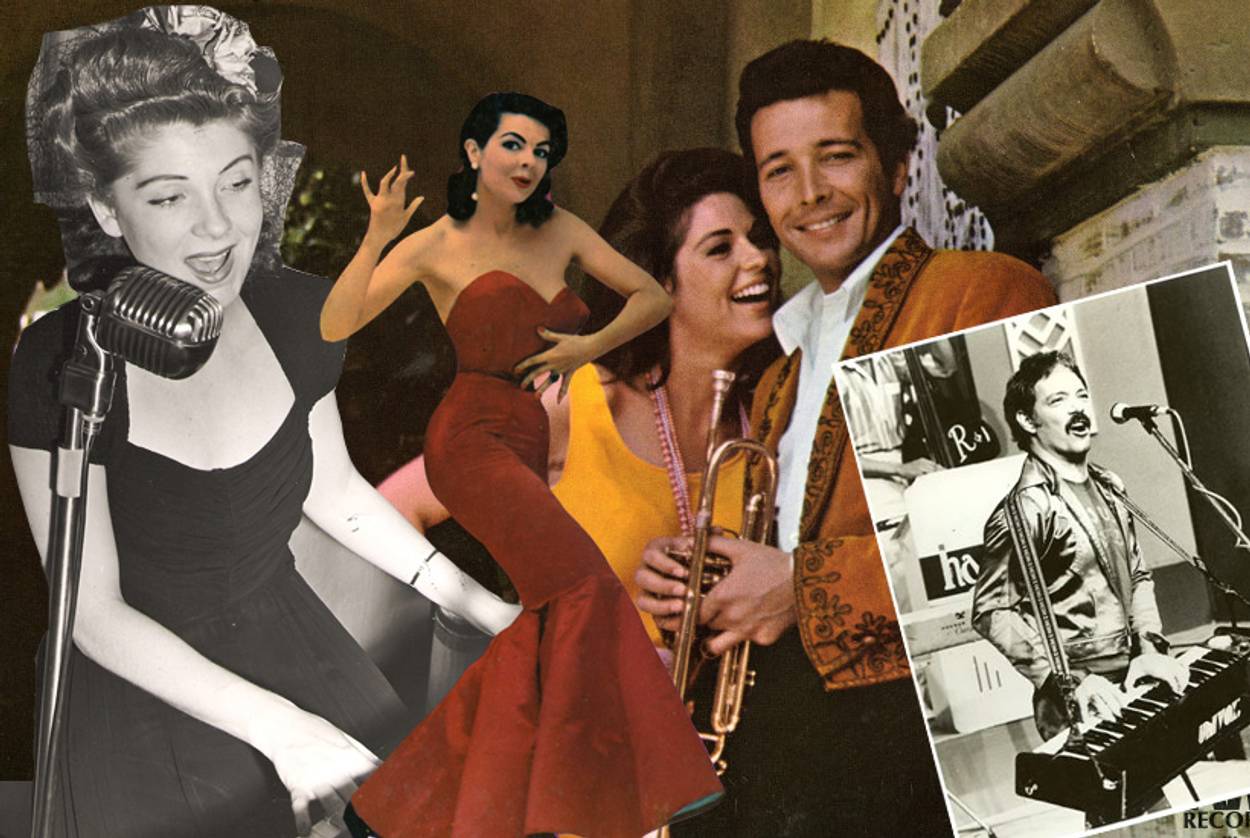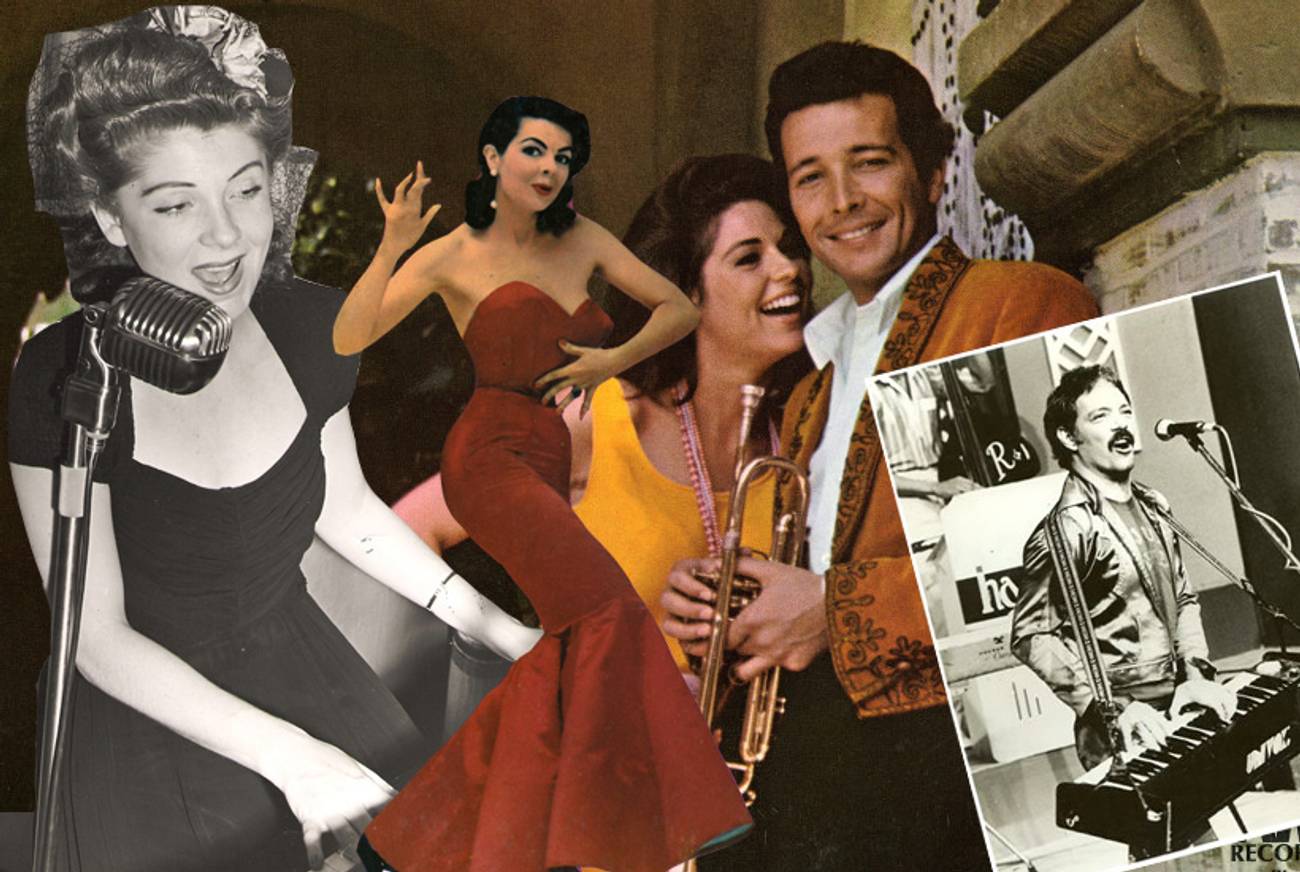Mambo Kings Play Songs of Love: ‘It’s a Scream How Levine Does the Rhumba’
A new compilation revives the once ubiquitous, now mostly forgotten Latin-Jewish connection of the 1940s to the ’80s




You learn so much listening to It’s a Scream How Levine Does the Rhumba, the new two-CD set of mambos, rhumbas, and cha-cha-chas from the 1940s to the ’80s. For example, that Jews had a reputation as great dancers. Or maybe pretty good dancers. Or good enough at tapping our feet, and maybe if we took some lessons, I don’t know.
And you learn that we could blow—man, could we blow—not just the walls of Jericho with our trumpets, or the walls between klezmer and jazz on clarinets like our kings of swing, Benny Goodman and Artie Shaw, but with the heavy-metal slide of trombones at the forefront of salsa music. If nothing else, It’s a Scream puts a long overdue spotlight on stellar trombone players such as Barry Rogers and Mark Weinstein. It also gives room to better-known Jewish musicians who worked the Latin beat occasionally (Stan Getz, Herb Alpert) or full time (Larry Harlow, Andy Harlow, Harvey Averne).
When the fictional 1950s Jets gang of Hell’s Kitchen were fighting (or having dance-offs) against the Puerto Rican Sharks in Leonard Bernstein and Stephen Sondheim’s West Side Story, a much more peaceful but no less lively interaction was taking place nearby at 53rd Street and Broadway, at the Palladium Ballroom. That’s where mambo maestros such as Tito Puente, Tito Rodriguez, and Machito were playing percussion, piano, and brass-driven dance music for a hard-partying mixture of Jews and Latinos. When not booked in ballrooms or theaters, many of the same musicians—by the 1960s a mix of Jewish and Latin players—sustained themselves on the bar-mitzvah and wedding-band circuit. That partly explains the three variations on “Hava Negila”—by Celia Cruz, Damirón, and Pérez Prado—in this package.
It is this once ubiquitous, now mostly forgotten subculture that is celebrated in It’s a Scream, put out by the Idelsohn Society for Musical Preservation, the culture vultures who’ve provided restorative surgery on audio relics from the diaspora dumpster on compilations such as the vaudeville package Jewface and reissued previous Judeo-Latino rhythmic classics such as Bagels and Bongos, by the Irving Fields Trio and Mazel Tov, Mis Amigos, by Latin and jazz greats Ray Barretto, Clark Terry, Doc Cheatham, and Charlie Palmieri working undercover, performing swinging versions of Yiddish tunes as Juan Calle and his Latin Lantzmen.
“The Latino-Jewish story is really crucial to understanding the complexities of identities and cross-cultural connections that have shaped and continue to shape multiracial and multicultural American life,” said Josh Kun, a co-founder of the Idelsohn Society and a professor in the USC Annenberg School for Communication and Journalism.
It’s a Scream develops chronologically, from vaudevillean Irving Kaufman’s “Moe the Schmo Takes a Rhumba Lesson,” complaining about every ache and counting every penny. Among the musical-historical jewels is “Mambo Shevitz (Man, Oh Man),” a tribute to the most famous of kosher wines by the Crows (backed by Melino and his Orchestra), the doo-wop group whose sole 1953 hit, “Gee,” was one of rock ’n’ roll’s earliest hits. And it ends with Larry Harlow, nicknamed “El Judio Marvilloso,” among the most prolific musicians, arrangers, and bandleaders of the late golden age of salsa. We’ve selected seven representative tracks to explore, and so—bailemos!
***
“It’s a Scream How Levine Does the Rhumba” by Ruth Wallis
Wallis may have been the most clever of the risqué female comics (Belle Barth, Rusty Warren) who played the “blue” piano bar, hotel lounge, and resort circuit with “adults-only” material in the repressed postwar years. The unmistakable sexual innuendos and gamy double-entendres of Wallis’ material made her popular from the theaters of Australia to the gay underground of the 1940s and 1950s. (Her “Queer Things” is a celebrated curio of closeted double lives in the pre-Stonewall era.) In the package’s title song, Levine’s ardent pursuit of rhumba dancing has him saying “don’t wanna” (nicely phrased by Wallis as “Don-Juana”) to Mrs. Levine’s needs when he gets home. On the dance floor, he pretends to be a Casanova “south of the border,” which leaves his wife “needing a boarder.”
“My Yiddishe Mambo,” by Mickey Katz and His Orchestra
Putting a Latin spin on “My Yiddishe Mama” must have been low-hanging fruit for master parodist Mickey Katz. The father of actor Joel Grey and grandfather of Jennifer Grey was also the spiritual forefather of the likes of Allan Sherman and “Weird” Al Yankovic. In the tense post-Holocaust, post-Rosenberg 1950s, when Anglicized name changes and unaccented English became the road to assimilation, Katz laid on the Yiddish accent and shtetl roots with a brazenness that made him “too Jewish” for some radio stations and promoters. On the plus side, he was a brilliant klezmer clarinet and saxophone player and had access to top-flight musicians to give his parodies such as “Davy Crockett” (“Duvid Crockett, king of Delancey Street”) and “My Yiddishe Mama” their lasting zetz. Mad Magazine’s meshugenah embrace of Yiddish-jargon in its early days probably owes much to the proud wit of Katz.
“Channah From Havana,” by The Barry Sisters
The Barry Sisters were versatile entertainers who from the late 1930s well into the 1950s were best-known for “Yiddish Melodies in Swing,” the live radio show that made them famous, and the show’s “Swingtette” featuring clarinetist Dave Karras kept old-world Jewish culture alive and accepted by the mainstream in the years before Fiddler on the Roof. “Channah From Havana” is a fascinating frisson that recalls a time when Cuba was on the vacation itinerary of affluent Jews. In one of many adulterous fantasies here, Channah goes on a cruise without her husband, falls for a Latin lover who turns out to be Sam Shapiro, just another Jewish man whose fancy footwork on and off the dancefloor made him catnip to the lonely or merely adventurous Mrs. Katzes of the world.
“Grossinger’s Cha Cha Cha,” by Tito Puente and His Orchestra
So, I’m playing a Tito Puente album a few years ago when my mother-in-law barges in—I mean, rings the bell politely—and schools me in Puente 101, the Bronx/Manhattan dance-party scene from the Hunts Point Palace to the Palladium and the Metronome. The former Esther Tissenbaum: a mambonik? Who knew? And if there was one “mambo king,” it was Tito Puente, the timbalero and bandleader at the forefront of every Latin music style from the 1940s on. During the summer, the bands and fans made it out of the sweltering city and had long-term residencies and vacations in the Catskills. It was win-win: steady paycheck for the bands, a chance for musicians and their followers to get out of the city, and the party never stopped. “Sometimes the husbands liked it, and sometimes they didn’t,” musician and writer Tania Grossinger, a distant cousin of the owners and the hotel’s one-time social director, told an interviewer, describing the often cozy setup between dance instructors, musicians, and hotel guests. In a similar vein, check out Machito and his Afro-Cuban Orchestra’s tribute to Grossinger’s rival, “Mambo La Concord.”
“Exodus,” by Ray Barretto
Otto Preminger’s epic drama based on Leon Uris’ novel (with a screenplay by blacklisted Dalton Trumbo) won both 1960 Oscar and Grammy awards as best song. This was good news for bringing Jewish and Israeli identity to mainstream American culture; not so good if you’re a young rock music fanatic seeking succor from the bounty of easy-listening instrumental hits crowding the radio in the wake of the payola scandals: Bert Kampfert’s “Wonderland at Night,” Lawrence Welk’s “Calcutta,” and piano duo Ferrante & Teicher’s version of “Exodus.” Conga player Ray Barretto was a visionary band leader with an ear to trends and the skill to transcend them. He would cross over to rock with the novelty “El Watusi” in 1962 and make money doing hip versions of James Bond themes before emerging as one of Fania Records’ defining artists later in the decade. His “Exodus” is, naturally, a trip: It begins with seething congas, and the rumbling rhythm never lets up, even as the dramatic melody soars, fueled by killer choruses of high-flying flutes and sassy saxophones.
“Watermelon Man,” by Mongo Santamaría
This 1962 pop hit was written by conguero Santamaría’s then-new pianist, Herbie Hancock. So, what’s the Jewish connection? The arrangements of Marty Sheller, that’s what. Sheller grew up in Newark, N.J. (and then lived in Newark, Del.), and was a drummer-turned-trumpeter who grew up with both jazz and latin. His trumpet solo and arrangement on “Watermelon Man” helped give birth to the Latin soul music known as “boogaloo.” It was another tune that had to be in the repertory of every band booked at either bar mitzvahs or weddings. It was also the precedent for many subsequent record label’s efforts to get Mongo another crossover hit.
“Yo Soy Latino,” by Larry Harlow
This 1983 track proudly states “I am Latino,” but if there was ever a musician who fully embodied the Latin-Jewish connection, it was Larry Harlow. Harlow was one of the most prolific composers, arrangers, and leaders of late salsa and released more than 50 albums for Latin leader Fania Records. During the early 1970s, some older beatnik friends and I would drive around New York smoking and aimlessly listening to “Symphony Sid” Torin, the Jewish disc jockey who had moved his program from jazz to Latin, focusing on Barretto, Harlow, Willie Colon, Johnny Colon, and the occasional vocal jazz tune by King Pleasure or Nina Simone. Harlow’s roots run deep on both sides of the music. Born in Brooklyn as Lawrence Ira Kahn, he had a grandfather who was a theater critic for the Forward; his father, Nathan Kahn, was a bandleader and bass player who played at the Latin Quarter for 20 years. Larry Harlow also traveled in Cuba and became familiar with not only the music but the spiritual concepts aligned with Cuban music. Which brings up the question: Can one observe Santeria rituals and still be a good Jew? This music will make you think anything is possible.
***
Like this article? Sign up for our Daily Digest to get Tablet Magazine’s new content in your inbox each morning.
Wayne Robins, a writer and journalist, teaches at St. John’s University in Queens, NY. He also programs the ‘Rock: Today and Yesterday’ radio channel at eMusic.com. He is working on a spiritual memoir.
Wayne Robins, a writer and journalist, teaches at St. John’s University in Queens, NY. He also programs the ‘Rock: Today and Yesterday’ radio channel at eMusic.com. He is working on a spiritual memoir.